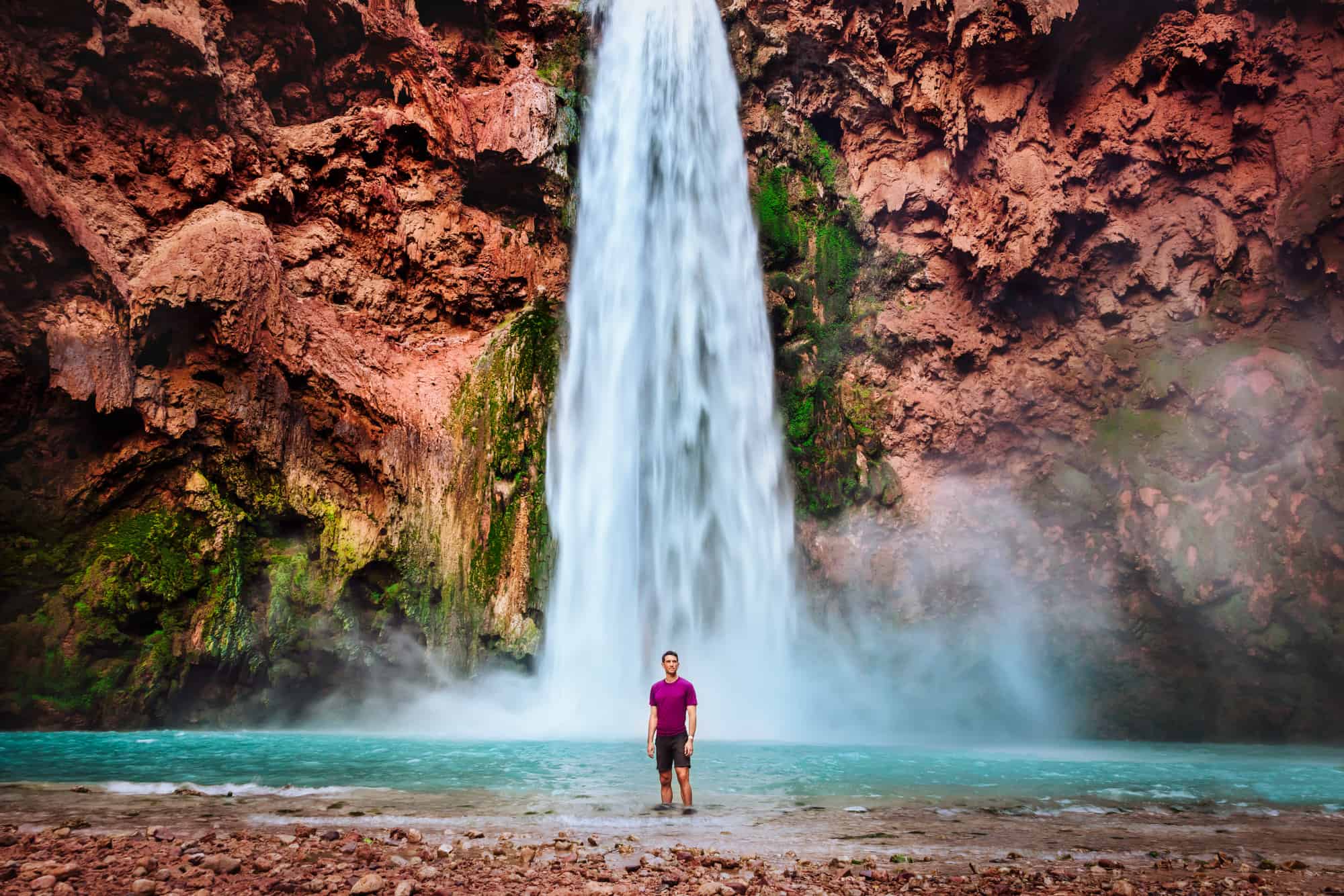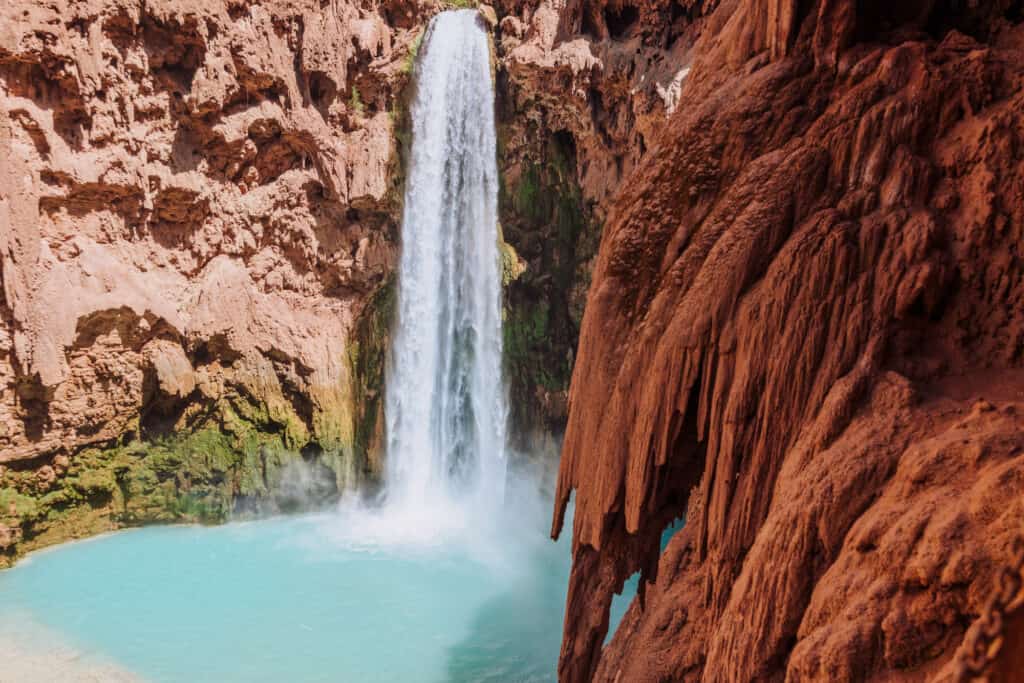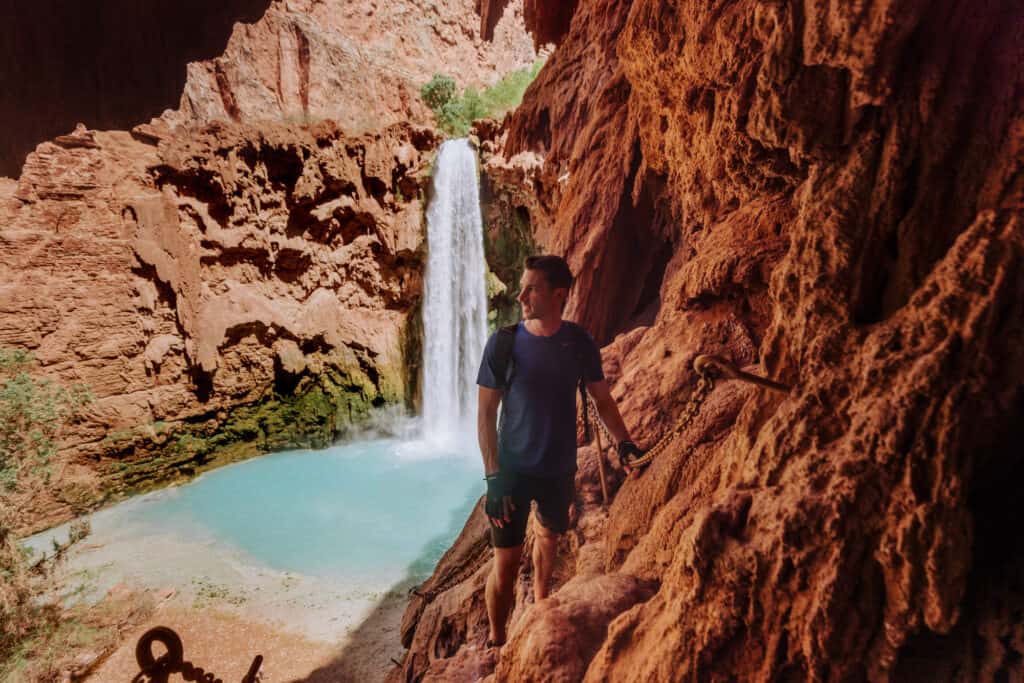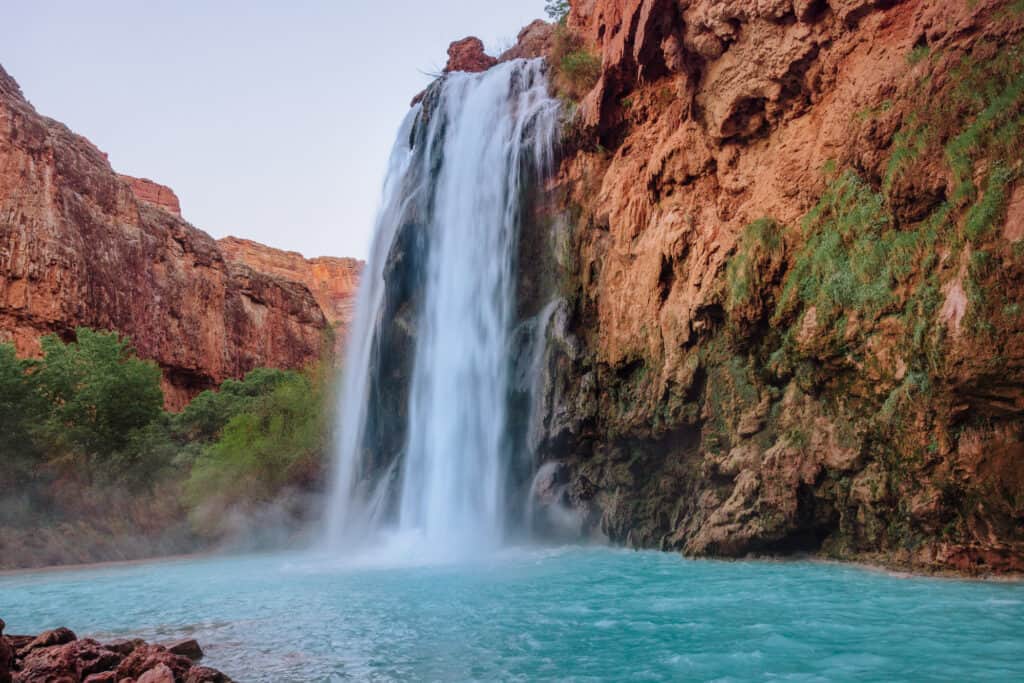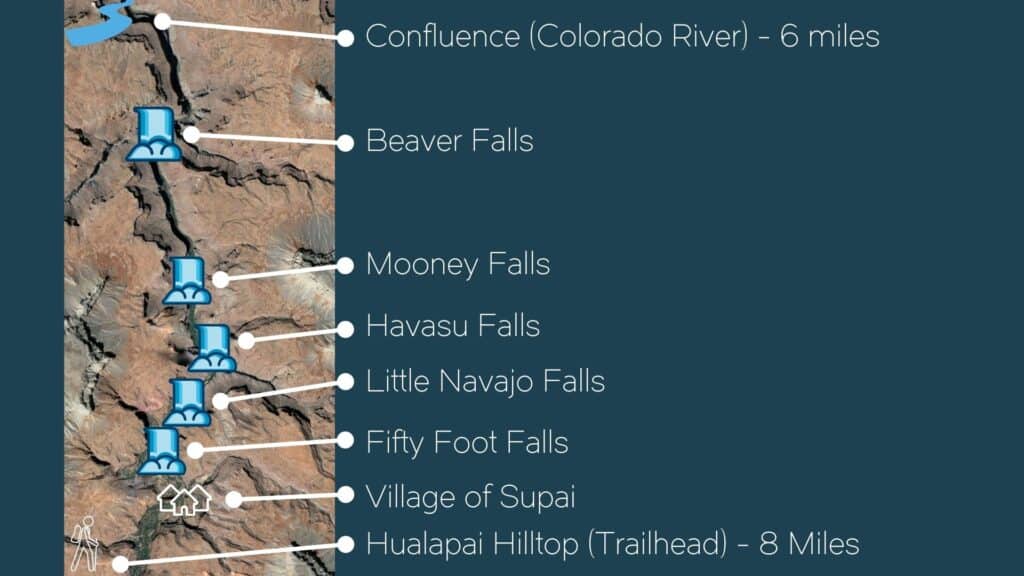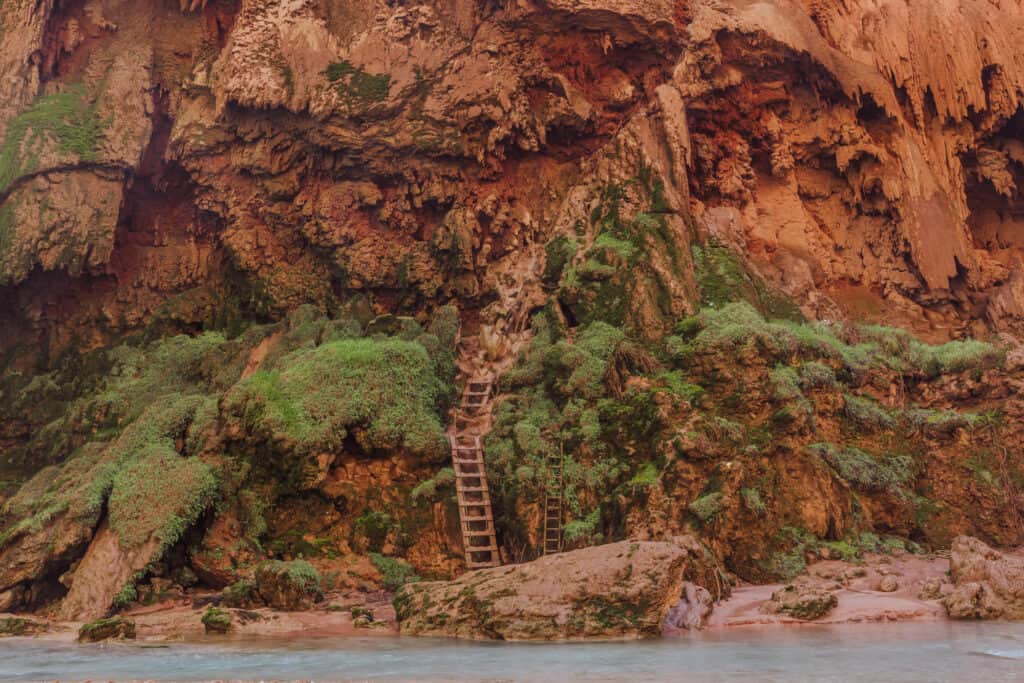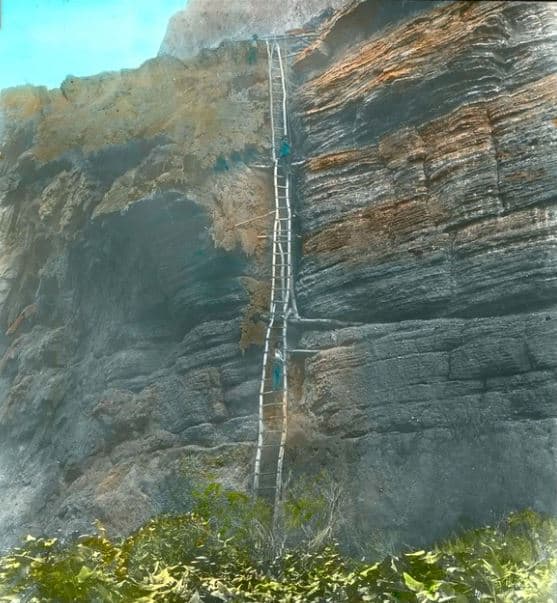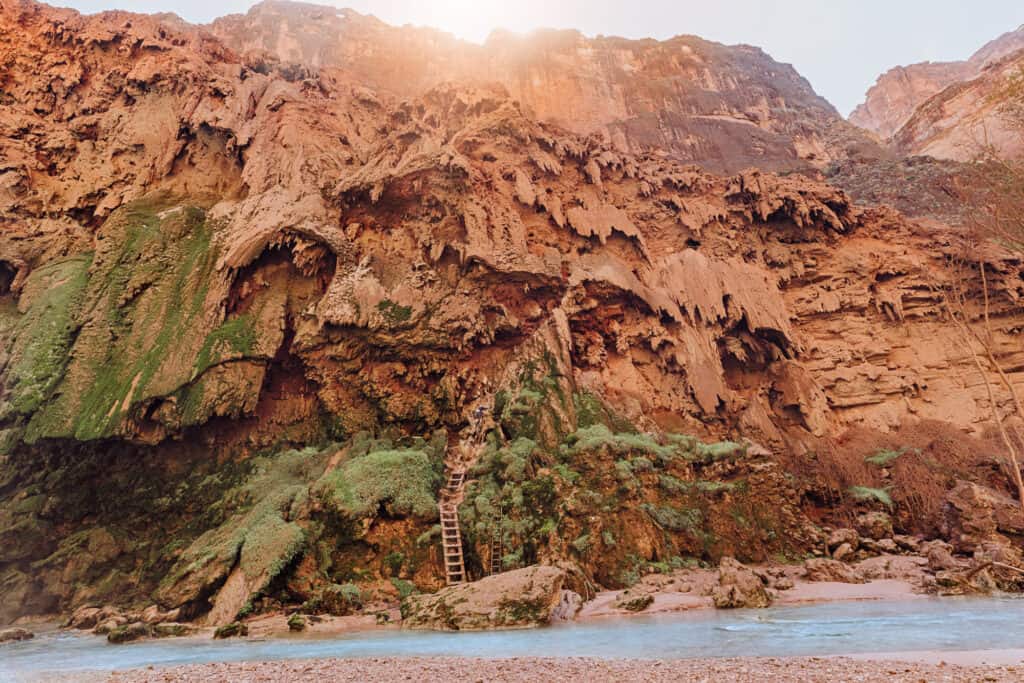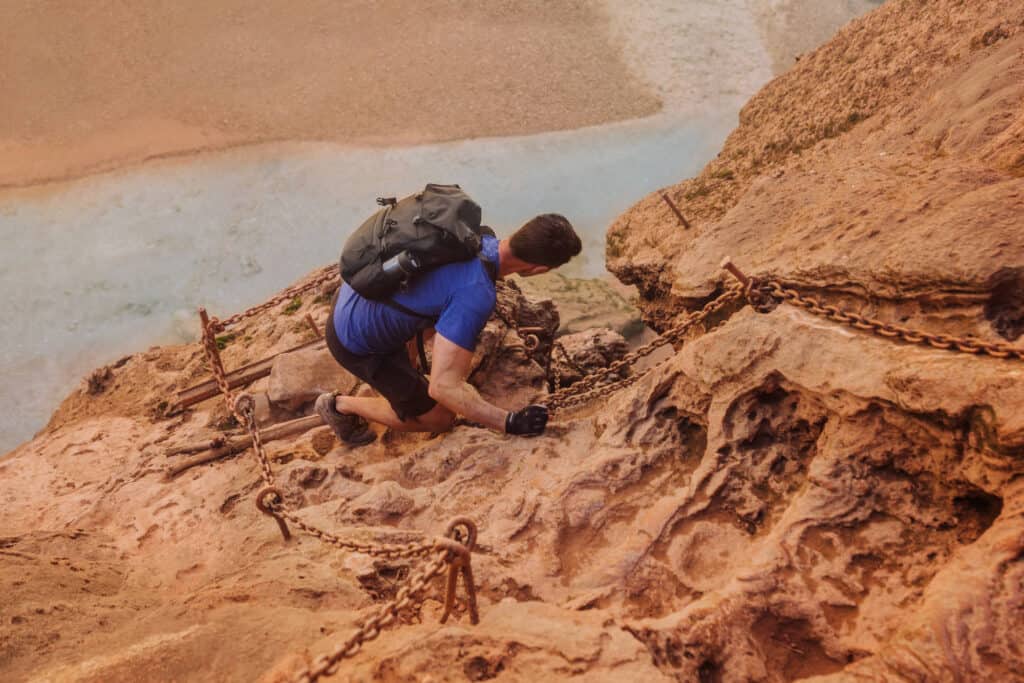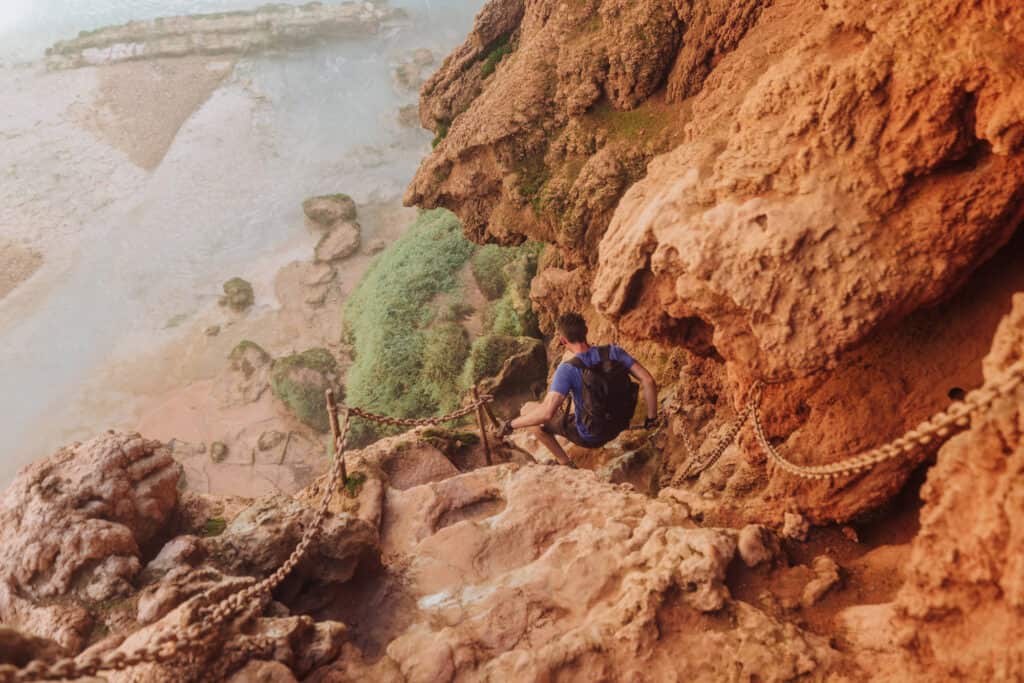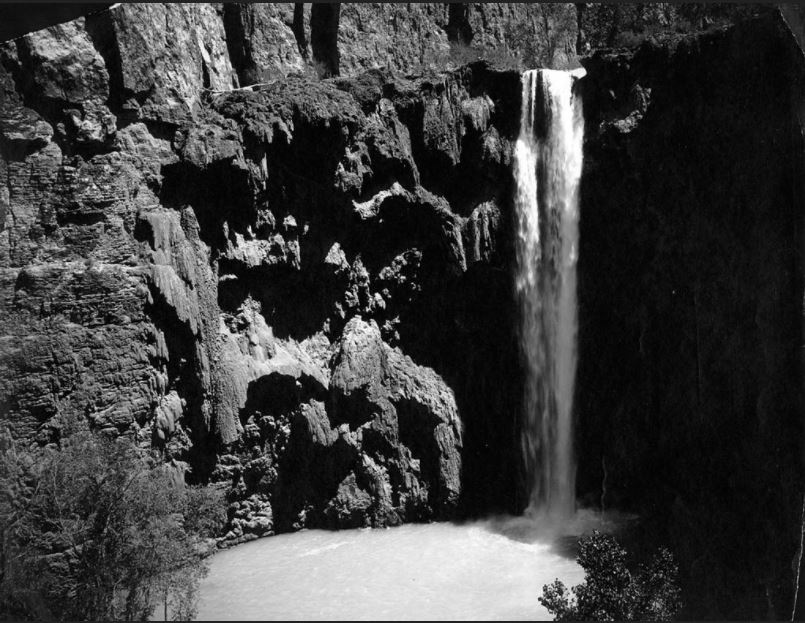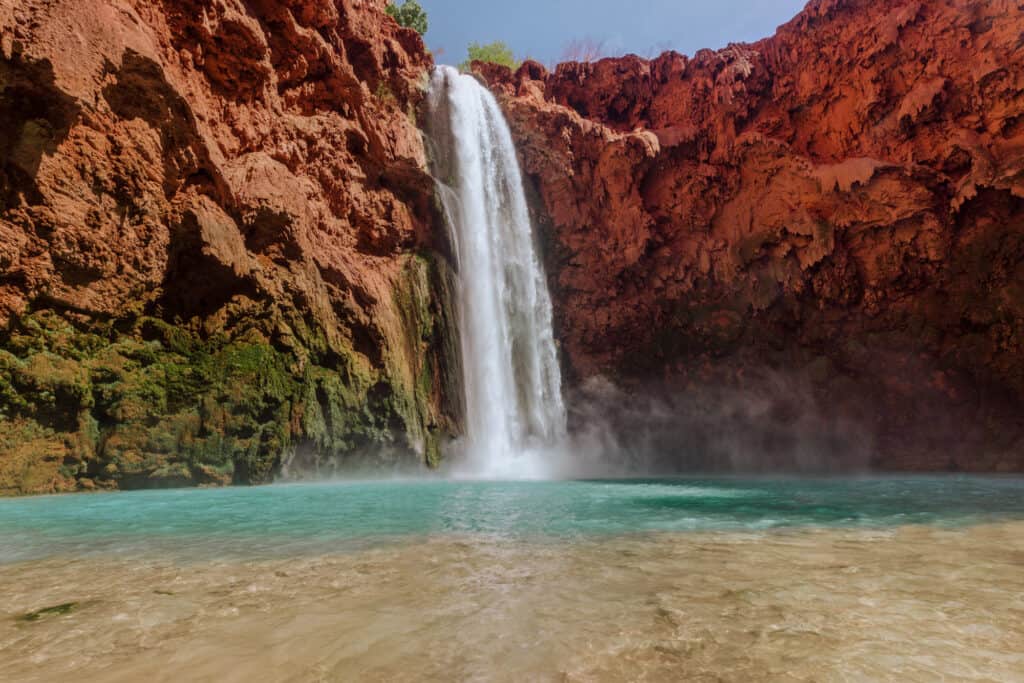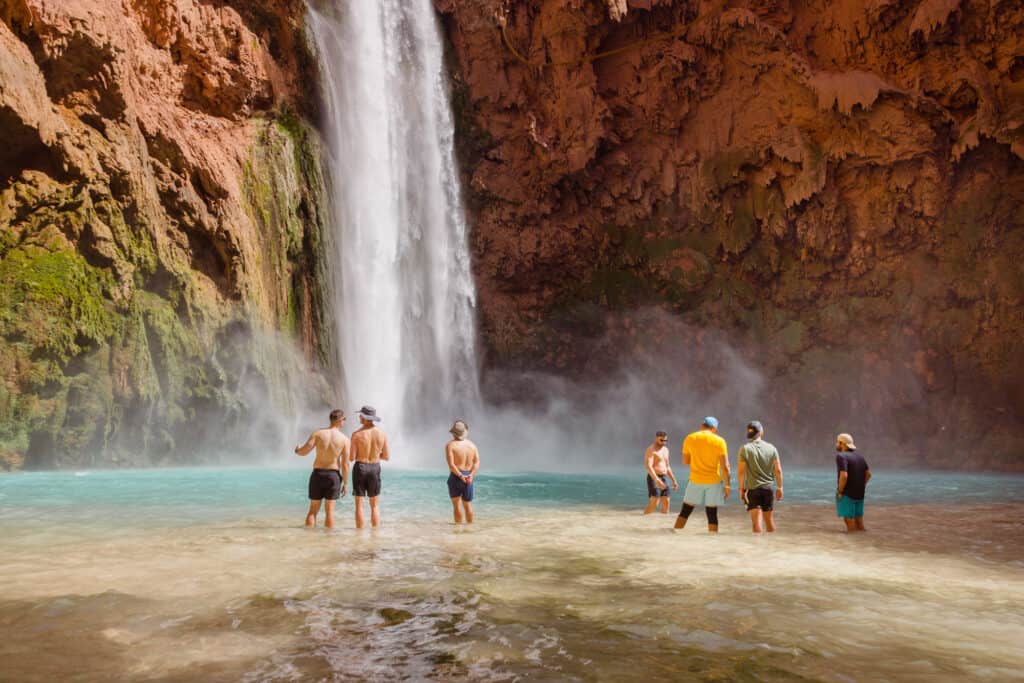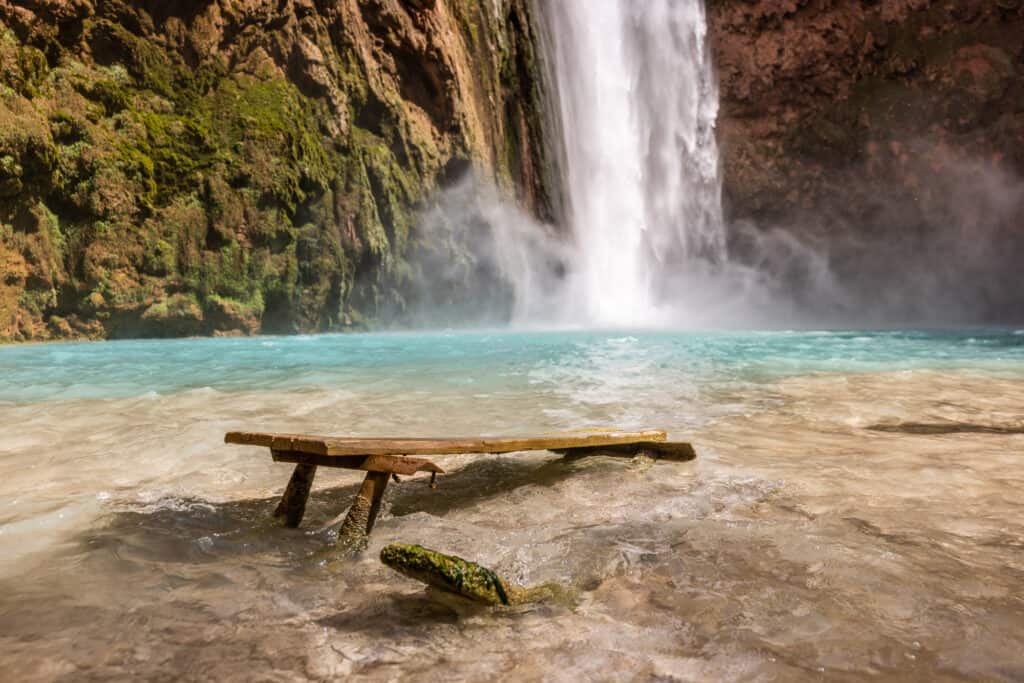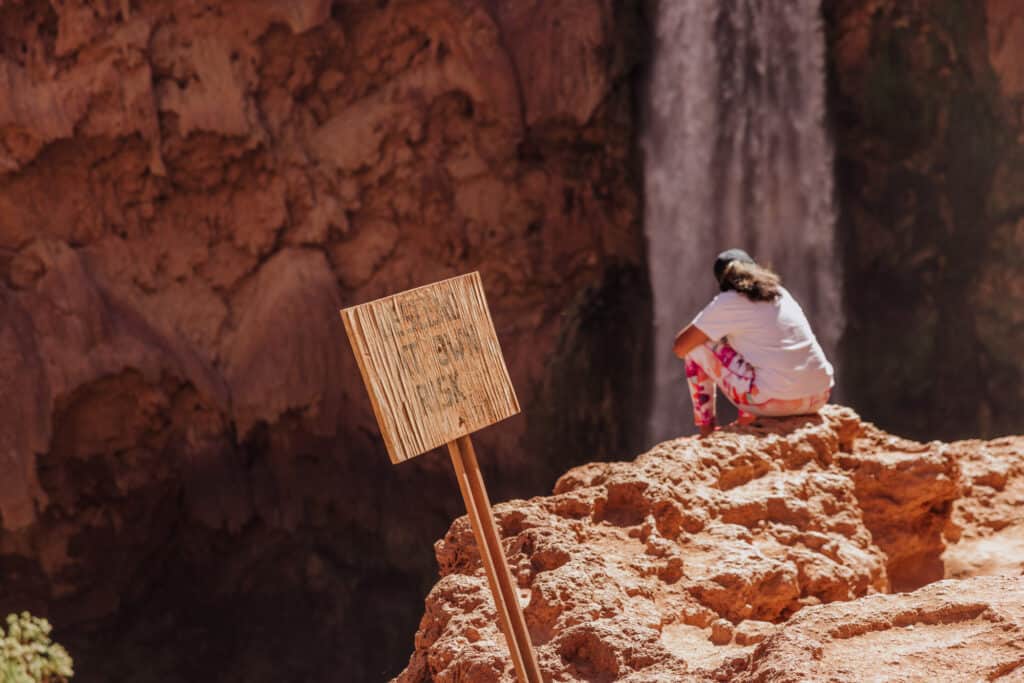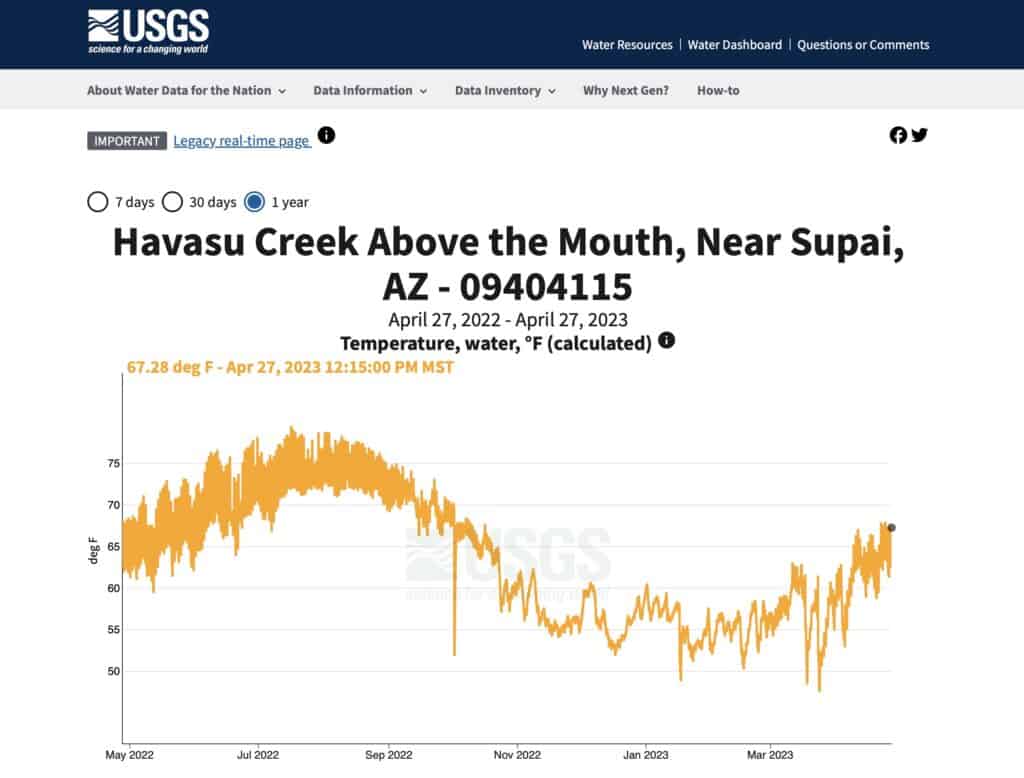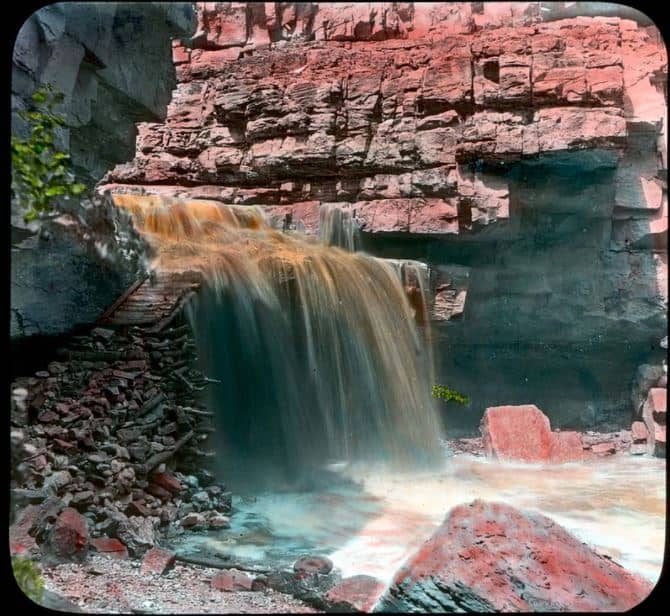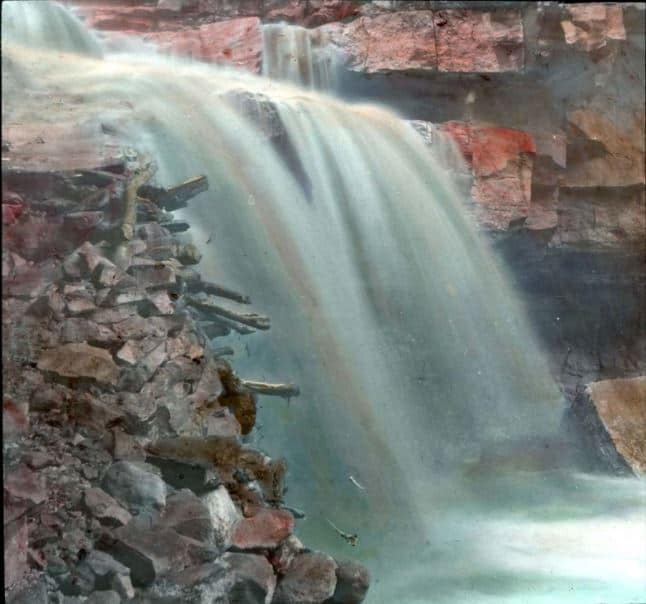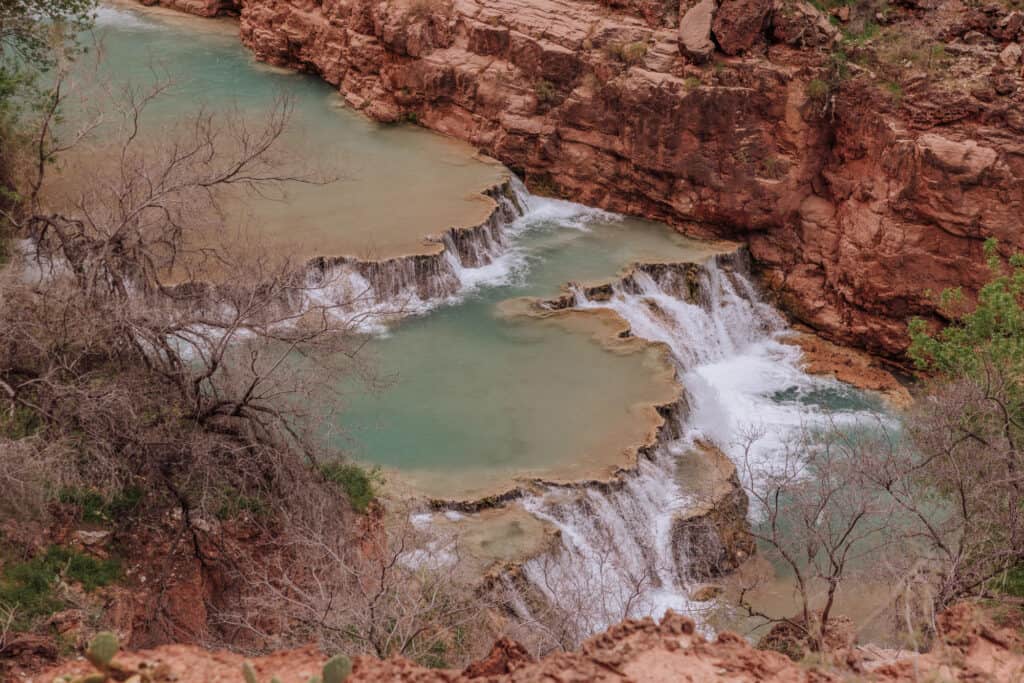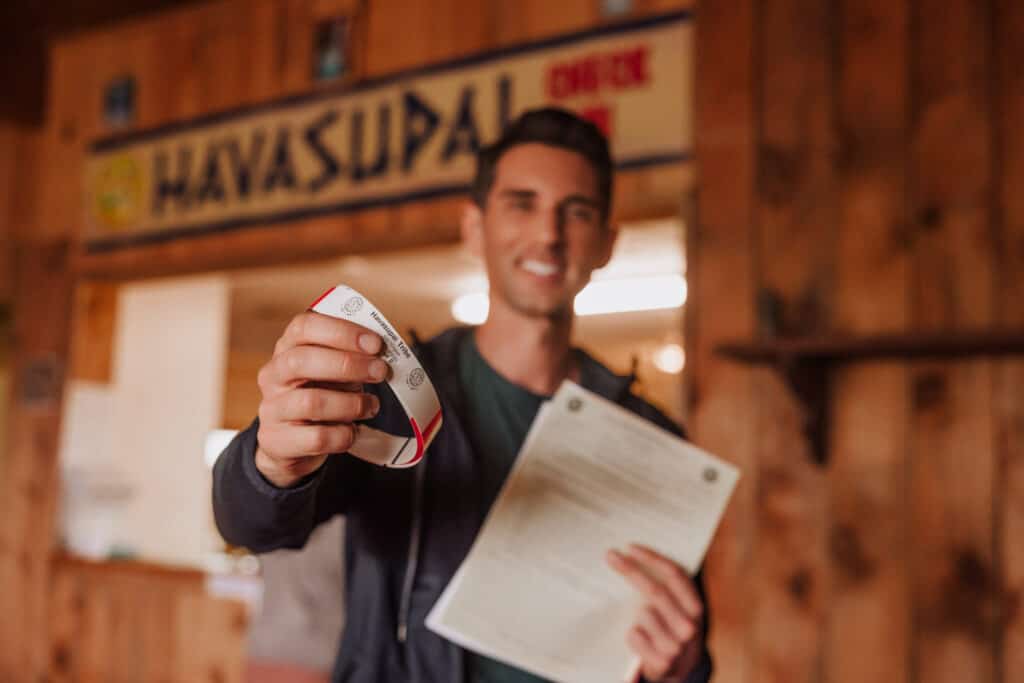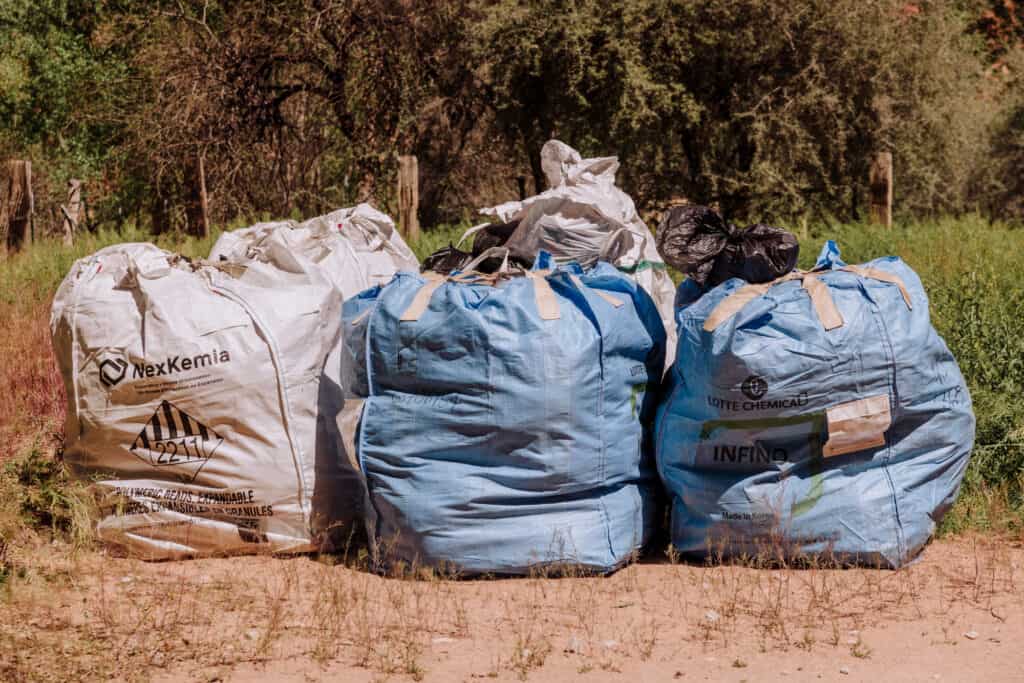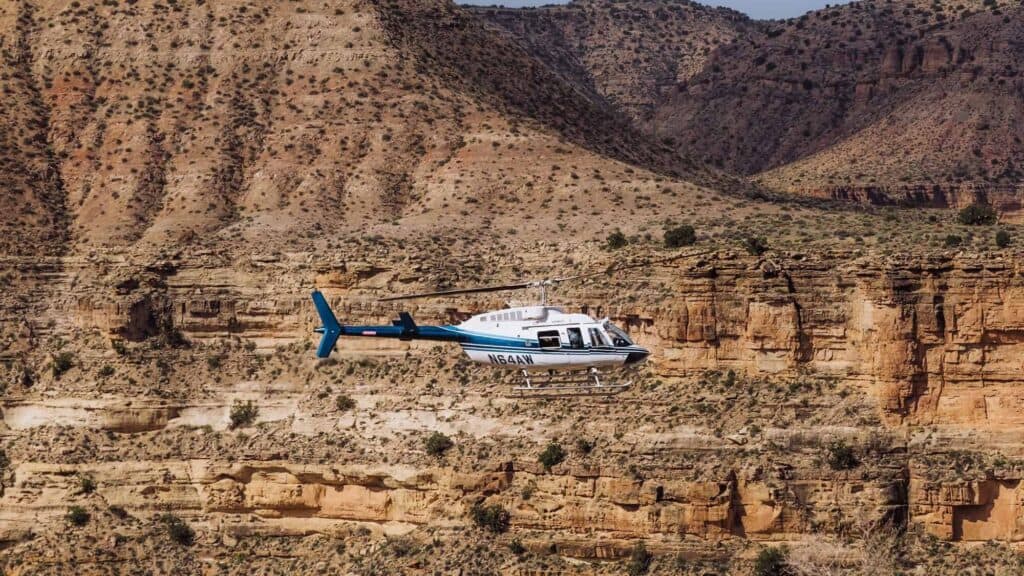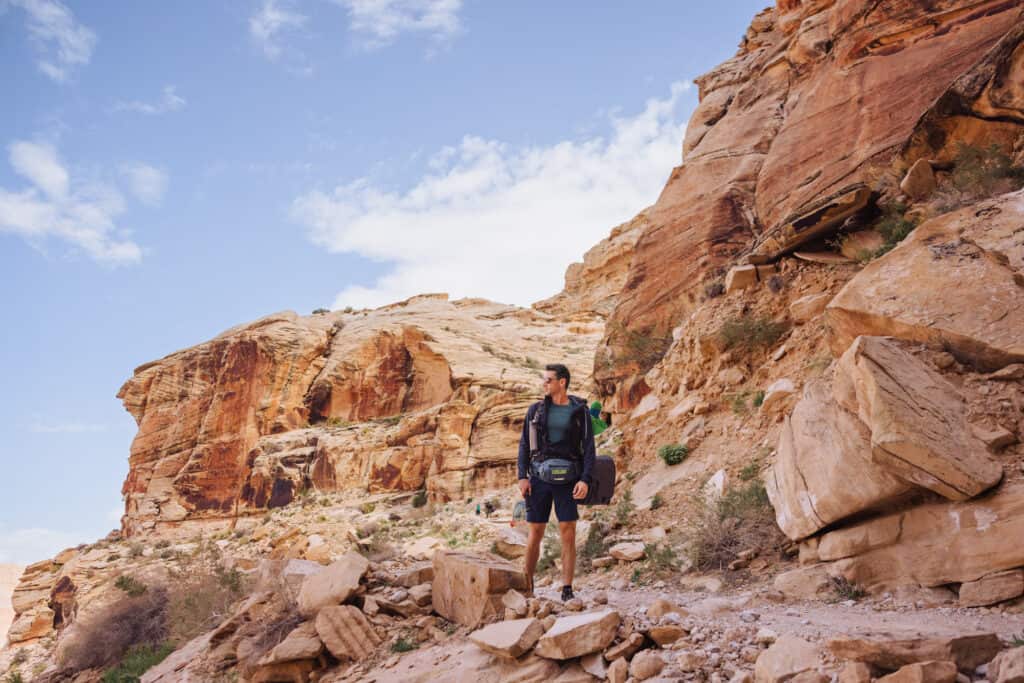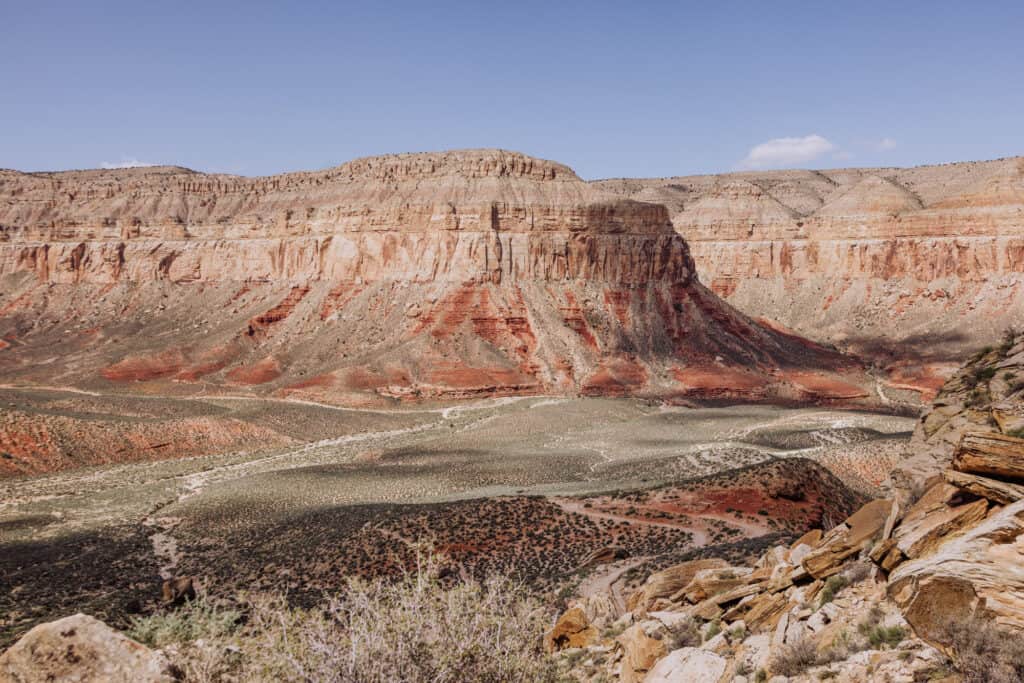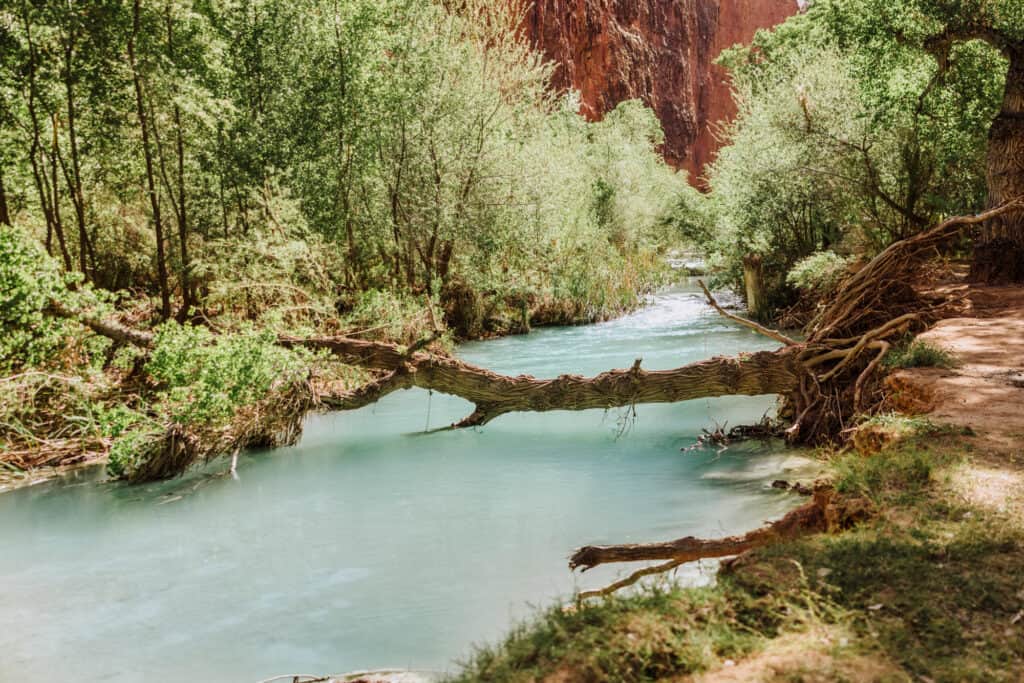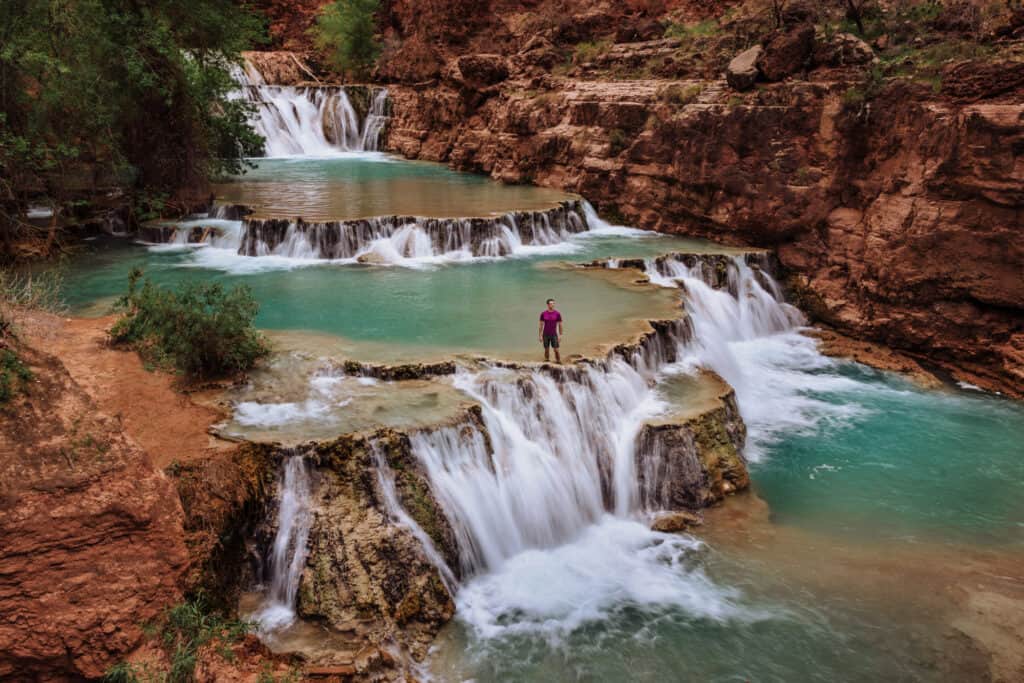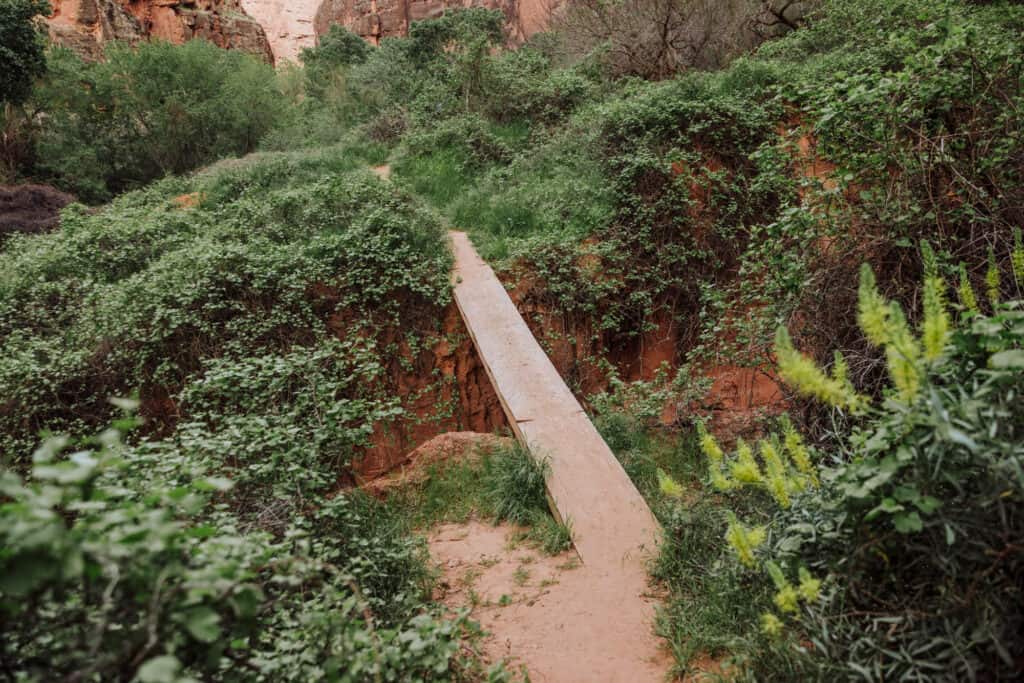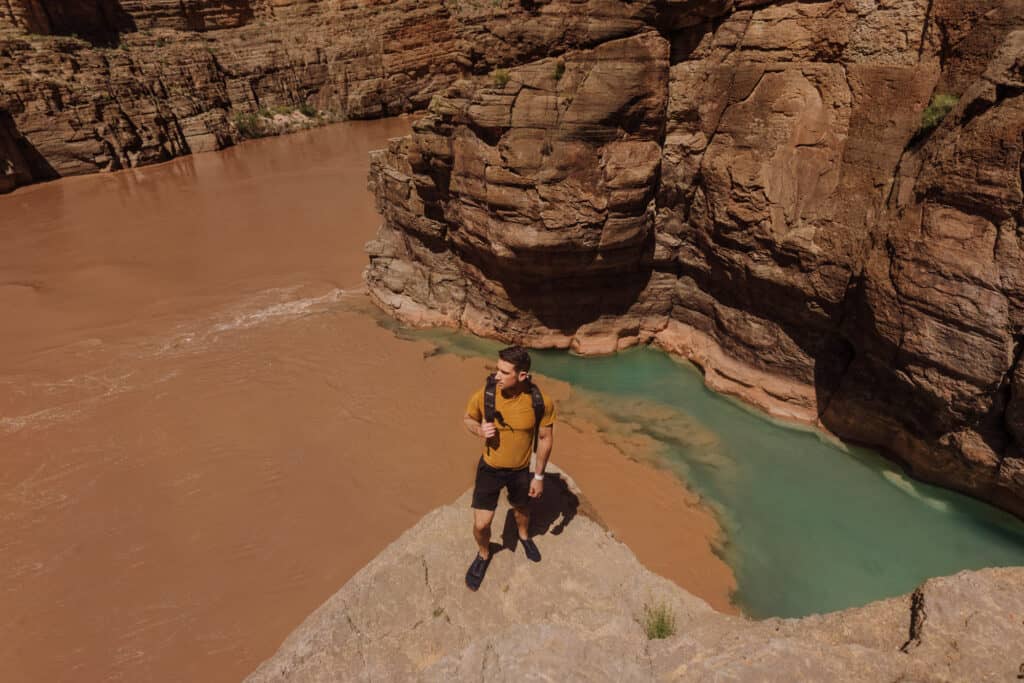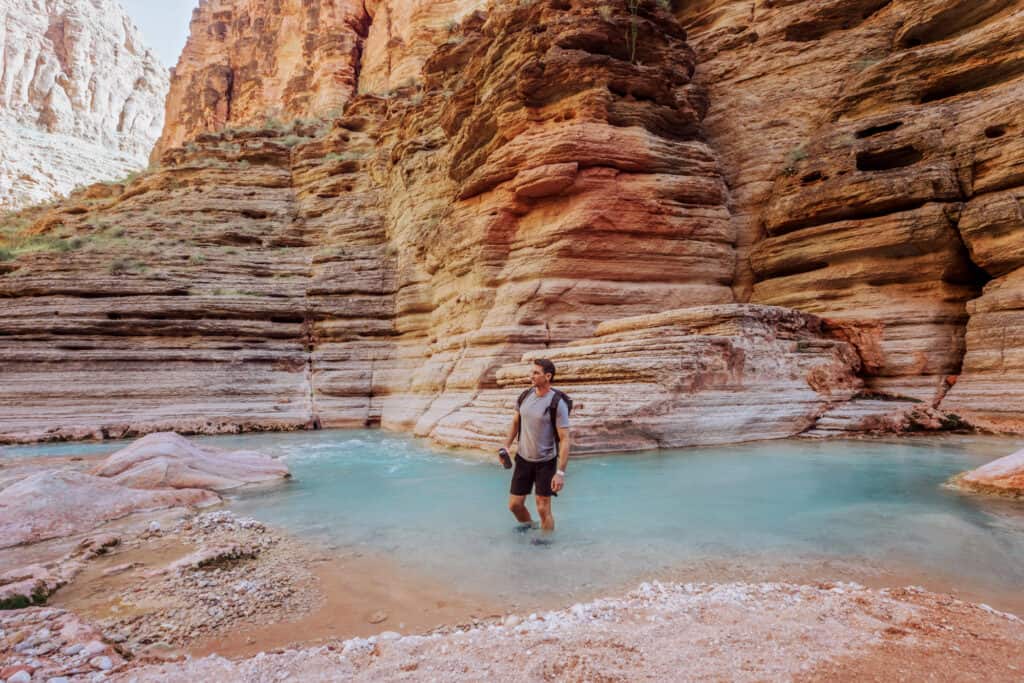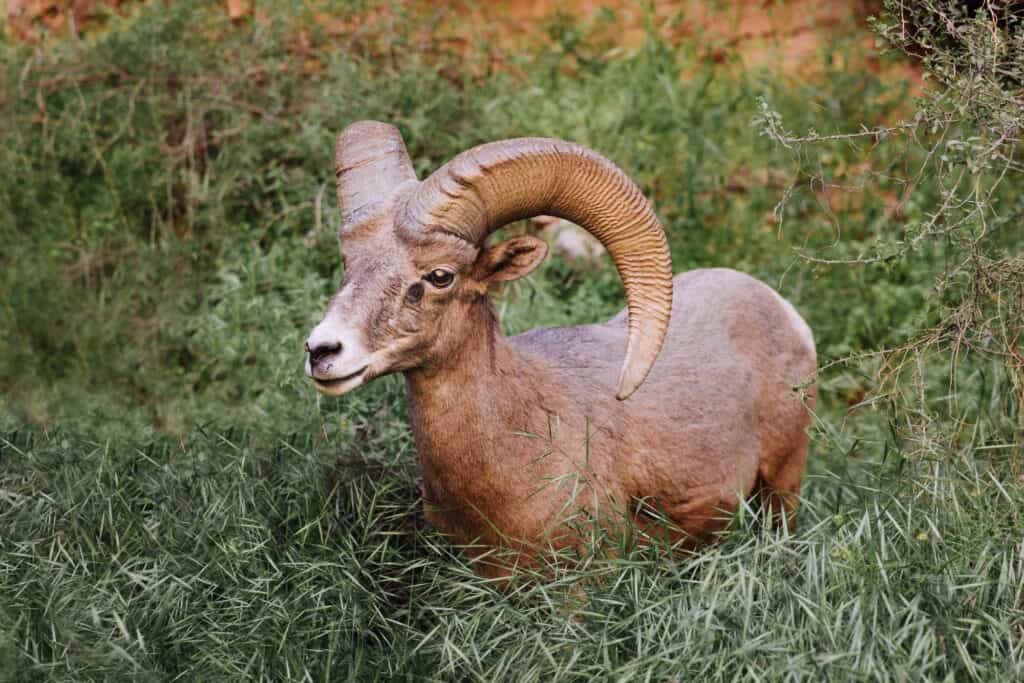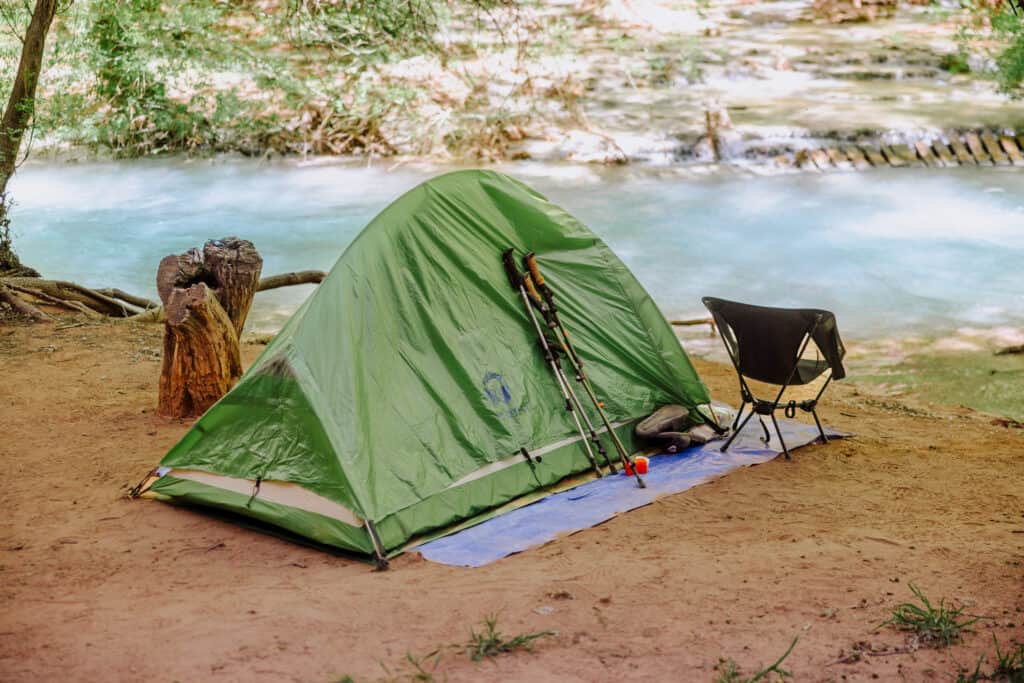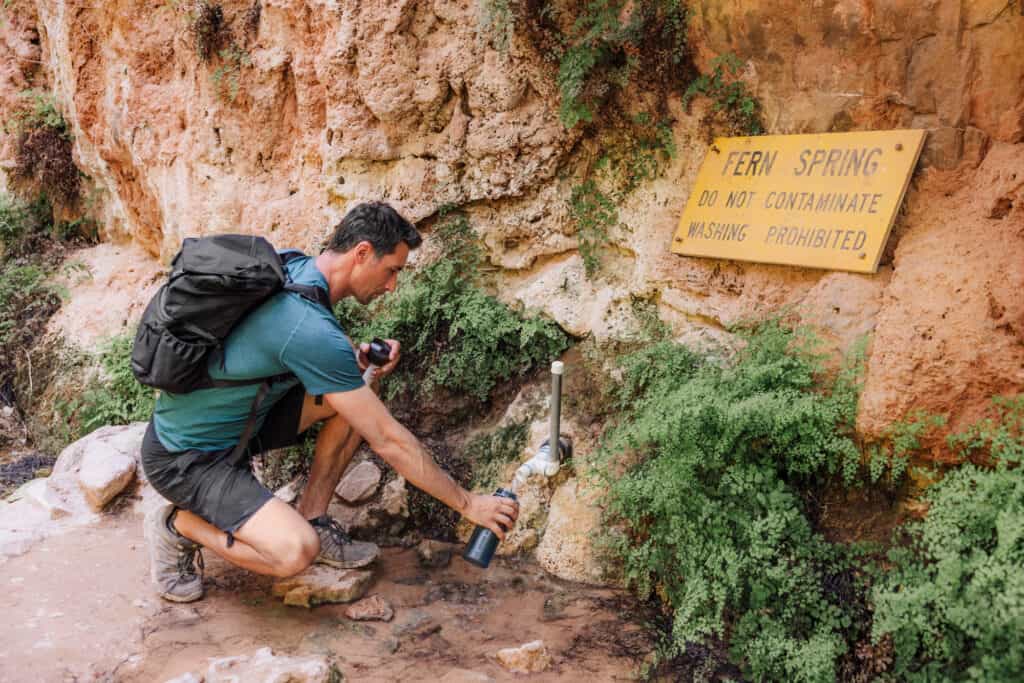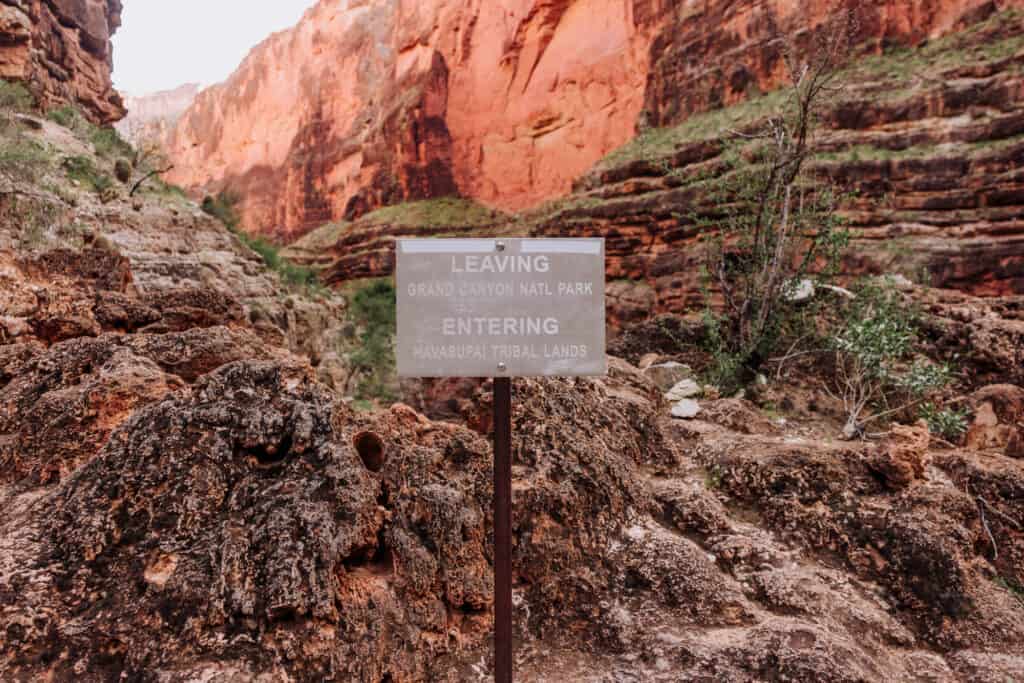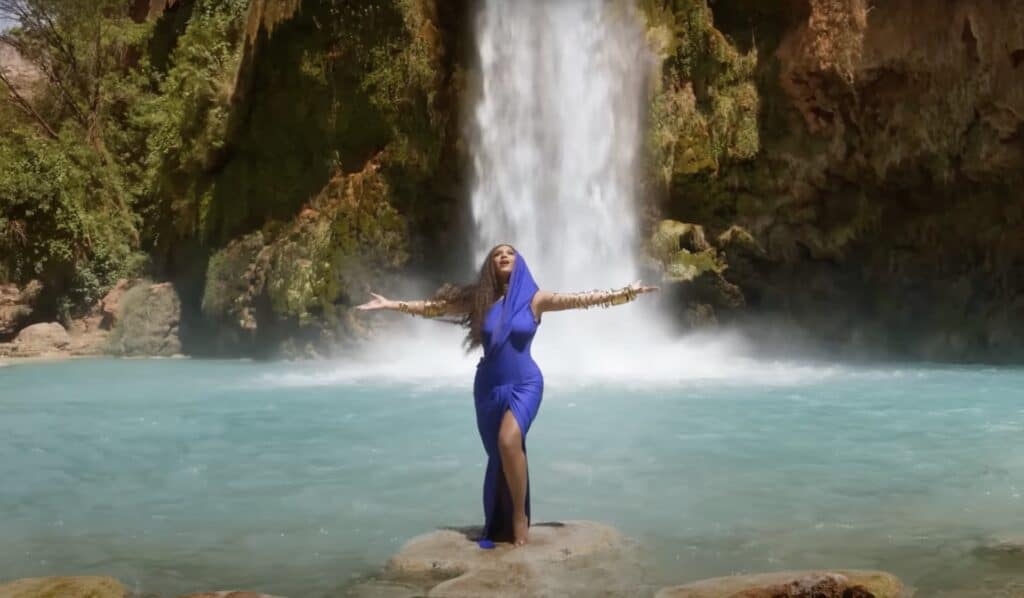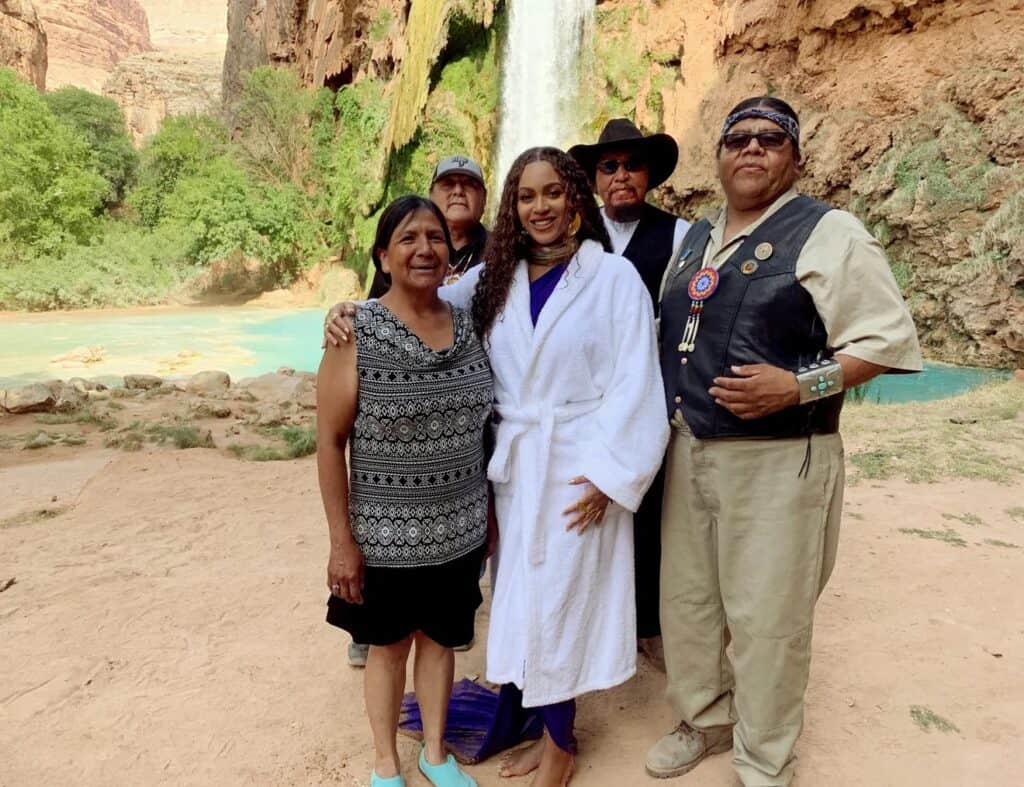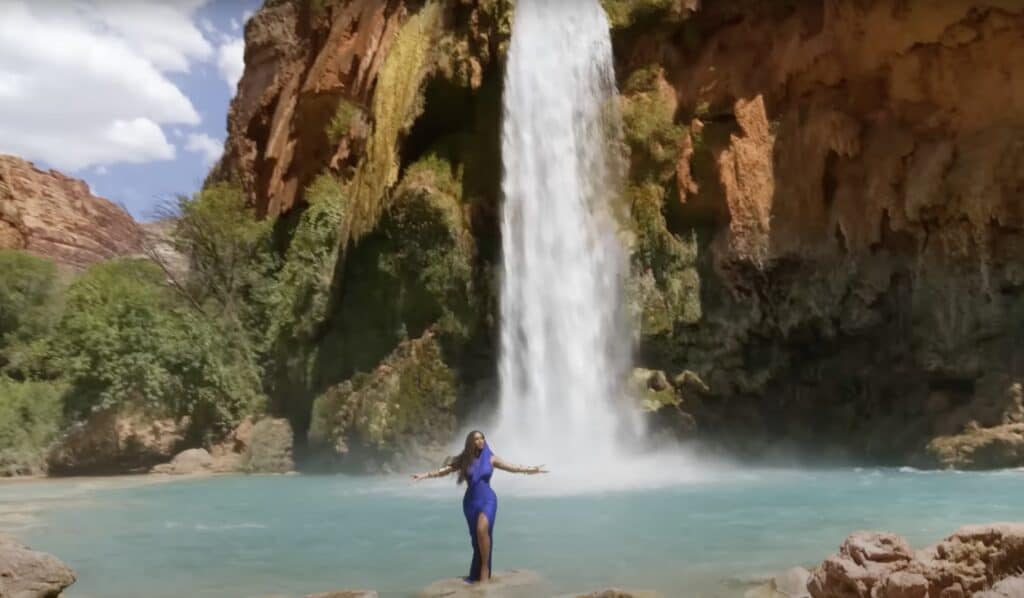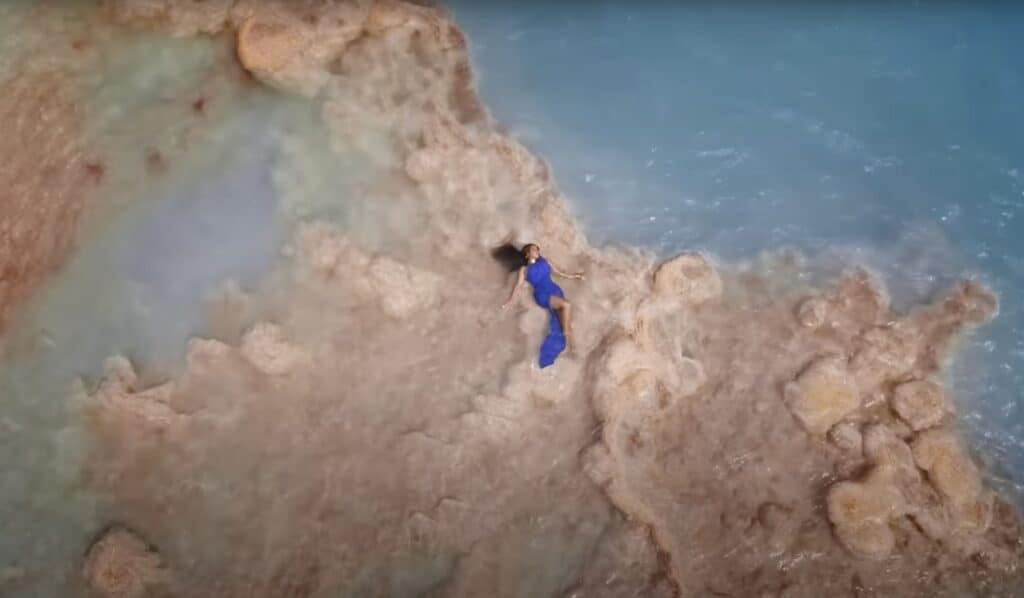Guide to Mooney Falls: Havasupai’s Biggest Waterfall
MOONEY FALLS: THE BIGGEST WATERFALL ON HAVASU CREEK
Mooney Falls is the biggest waterfall along Havasu Creek. The spring-fed, blue water in the creek passes through the Havasupai Reservation near the Grand Canyon in Arizona.
Havasupai means “people of the blue-green water,” and the Tribe has been around Mooney Falls for 700 years.
Only recently, thanks to social media, has the rest of the world become aware of (and fascinated by) the beauty of Mooney Falls, and seeking a permit to visit Havasupai.
Key Takeaways on a Hike to Mooney Falls
- Mooney Falls is right at the end of the Havasupai Campground.
- You can see the falls without climbing down the rocks and wooden ladder.
- The hike (or climb) down to the bottom of Mooney Falls isn’t for everyone. Visitors to Havasupai Falls should know their own limits, and be okay with their personal decision to scale the rock wall or not.
- The payoff is worth it if you can get over your fears and concerns, take it slowly, and make your way down the cliff.
Mooney Falls Map
The Havasupai Falls Campground runs along Havasu Creek, between the two biggest waterfalls: Havasu Falls and Mooney Falls.
Walking down the final stretch of the trail to the campground entrance, you’ll first see Havasu Falls off to the right. It’s the perfect welcome!
The landscape along Havasu Creek in the campground is lush, and continues for nearly a mile. The campground ends with a cliff at the top of Mooney Falls.
The Mooney Falls Hike, Ladders & Chains
The hike down to the base of Mooney Falls is famously challenging and also divisive!
For some, it’s a highlight of their visit to Havasupai Falls. For others, it’s a necessary terror to endure to continue exploring Havasu Creek. And for others, it’s a “hard no.”
Here’s the view from the bottom of the lower half of the climb:
It’s a 200-to-250 foot vertical descent from the top of the cliff down to the blue pool below Mooney Falls.
It starts with a nice, rocky/sandy path down from the end of the Havasupai Falls Campground.
Tunnels in the Rock at Mooney Falls
There are two tunnels you’ll pass through, each with a pretty steep downward slope.
In 1883, a mining group decided to create a more accessible route down the cliff to the base of Mooney Falls. This photo from around the turn of the century shows the ladder miners used to use to get to the top of Mooney:
The miners blasted two tunnels through the travertine, which hikers still rely on more than a century later to descend to the base of the falls.
The tunnels aren’t long. As soon as you’re in them, you can start to see the light at the end of each tunnel.
The Mooney Falls Descent
After the tunnels, things get much steeper. In fact, it’s almost a straight vertical drop-down from here.
You’ll find chains attached to spikes in the rock that you’ll want to rely on heavily. Gloves are very helpful here. I went down once without gloves and regretted it! (Of course, it didn’t help that my hands were sweaty from my terror 😅)
As for footing, there are jagged “steps” cut into the rock along the way. I’m not sure if they’re naturally there, or if they’ve been cut purposely.
Toward the bottom, the chains will end and you’ll just have to climb a wooden ladder to the base of Mooney Falls. It’s the easiest part of the descent.
You do *not need spikes on your shoes to climb down Mooney.
Adding to the challenge: the mist. Depending on the wind, Mooney Falls throws off a heavy mist that will coat you (and chill you) as you climb down.
Thankfully, the steps and rocks are *not slippery! There’s no moss or anything growing on them to make the descent more treacherous.
At the base, you can go explore the pool, or take the trail which will bring you down Havasu Creek.
Expect a Line to get Down Mooney Falls
The path down Mooney Falls, along the tunnels, chains, and ladders, is narrow. There’s only room for one person at a time. This creates a bottleneck at different times during the day.
Early in the morning, you might have to wait in a line of people as it slowly moves through the tunnels and down the cliff.
Getting back up can be a test of your patience. One of the days we were there, people waited two hours (in the mist) for a lane to clear for them to climb back up.
There’s really no way to predict for sure when you’ll have to wait in line at Mooney Falls. Generally, late in the day, the ladders are clear.
Too Scared to Climb Down Mooney?
Climbing down Mooney Falls is definitely not my favorite part of a visit to Havasupai Falls, so I understand how the descent is too much for some people!
Still, you should be fine going down the initial rocks and through the tunnels. You’ll get a great photo at the end of the tunnels with Mooney Falls in the background. Maybe it’ll inspire you to make the full climb the following day?
Mooney Falls Deaths & Rescues
You rarely hear of people falling on the descent down Mooney Falls itself. On the other hand, you hear a lot of stories about hikers getting injured and having to be flown out.
No one plans on needing a medical evacuation, but it’s one of the main reasons I always get travel insurance for a Havasupai Falls trip. After a lot of research, I found only a couple of policies that cover everything you’d need. I go with Travel Guard.
The Travel Guard “Preferred Plan” covers trip cancellations and emergency medical evacuation if something goes wrong. Every year, visitors are airlifted out with injuries, and the helicopter alone can cost over $10,000.
I also add two optional upgrades: “Cancel for Any Reason” for extra flexibility and the “Adventure Sports Bundle” for additional coverage tailored to more active trips.
➡️ Click to Checkout Travel Guard
Rescues & Warnings
The Havasupai Tribe has a helicopter landing spot near Mooney Falls for emergencies, though at times it’s inaccessible if a flood has recently gone through.
The Tribe posts warnings at the top of Mooney Falls, telling hikers they’re about to descend at their own risk. Injured hikers are told: they’ll have to foot the bill for their rescues, if it involves a helicopter hoist from below Mooney Falls.
There is no “check-in” system or anything. No one is watching from the top at sunset to see if everyone who went down during the day has made it back up. You’re truly on your own.
In addition to Mooney Falls’ namesake, D.W. “James” Mooney, several other deaths have occurred here.
July 2010 Death at Mooney Falls
- A 32-year-old-man from Ogden, Utah, was camping at Havasupai and swimming in the water at the *top* of Mooney Falls. Witnesses say he went underwater and never resurfaced.
- The Coconino County (Arizona) Sheriff’s Office says the current took the man over the falls.
- His body was found in Havasu Creek 100 yards downstream.
June 2012 Death at Mooney Falls
- A 16-year-old boy from St. George, Utah, visiting Havasupai Falls with his Boy Scout Troop, drowned in the pool at Mooney Falls. The Coconino County Sheriff’s Office says several of the scouts were swimming in the pool right under Mooney Falls, and may have been trying to swim right through the falls themselves.
- Deputies say the undercurrent pulled the boy under, and nearly pulled another with him.
- While one of the others in the group was able to pull the boy to shore, CPR efforts failed to revive him.
- Meanwhile, other scouts became trapped behind Mooney Falls. The adults with the group formed a chain to safely get the others to shore.
Mooney Falls Height & Stats
Mooney Falls is the tallest waterfall along Havasu Creek. The water drops about 200 feet into a beautiful blue pool below the cliff, marking the end of the Havasupai Falls Campground.
How did Mooney Falls get its Name?
Mooney Falls got its name after a tragic death in 1882, involving a miner named D.W. “James” Mooney. There are varying versions of the story, but there seems to be a consensus that Mooney was trying to climb the rock wall with a fellow injured miner on his back when he fell.
This photo from the Grand Canyon National Park’s museum collection was taken a couple of years later, in 1899:
Why is the Water so Blue at Havasupai Falls?
The creek is fed by rain and snow-melt from the Kaibab Plateau, which runs through the rocks, collecting minerals along the way.
A sign at Havasu Falls says the creek gets its turquoise color from a heavy concentration of lime. Geologists say the sunlight also reflects dissolved calcium, magnesium, and calcium carbonate in the water to create the blue hue.
Swimming in Mooney Falls
The beautiful blue pool of water at the base of Mooney Falls is so inviting, especially on hot summer days! You’ll have plenty of room to wade around in the water, but be aware of the dropoff into the deeper part of the pool. The water is usually clear enough to see where the white lime-covered rock floor disappears.
For years, an old picnic table has been setup off to the side of Mooney. Depending on the water level, you can have a seat there and the water will go up past your lap.
It’s Risky to Swim at Mooney
Also, keep in mind the dangers of swimming around a waterfall of this magnitude. Mooney Falls is not safe to swim under or behind. There’s a current and undertow, which have been deadly in the past.
There’s no rock jumping or cliff diving allowed, and there are signs warning you that you descend and swim at your own risk.
Havasupai Falls Water Temperature
The water temperature in Havasu Creek fluctuates through the year.
Don’t believe the blogs that say it’s always around 70 degrees! While that’s true during the summer months, during the spring and fall the water temperature is in the low-to-mid 60s. During the winter, the water temperature dips into the 50s.
You can always check the current water temperature, thanks to the US Geological Survey, which has a thermometer gauge in Havasu Creek. It’s interesting to see how the water temperature even fluctuates by five degrees over the course of a day!
Here’s a sample of a year’s worth of water temperature readings from the USGS gauge in Havasu Creek.
Mooney Falls Floods
The Havasupai Falls have been impacted by many major flooding events over the years.
The most devastating flood in recent memory hit in 2008. Two days of monsoon thunderstorms in August triggered flooding along Havasu Creek, which physically changed the course of the creek.
Here are just a few examples of some of the major floods over the years:
- 1910: The largest flood ever recorded destroyed the entire Supai village
- 1935: Houses in Supai again flooded with knee-deep water
- 1970: 10 flash floods swept through Havasupai in one summer
- 1990: A 14-foot wall of water wiped out the village of Supai
- 1997: Flood damaged the campground and village
- 2002: Havasu Creek flooded, forcing a campground evacuation
- 2005: Another 14-foot wall of water hit the village and damaged the campground
- 2008: Flooding caused extensive damage to waterfalls, trails, and campground
- 2012: Flooding again caused extensive damage to trails and campground
- 2018: Flash floods trapped 172 campers, who had to be evacuated by helicopter
- 2022: The gauges in the early warning system failed to alert of a flash flood
- 2023: Snowmelt caused flooding and campground evacuation
- 2024: Deadly flash flooding in September wiped out the trail, damaged Supai, and swept through the campground
The Grand Canyon National Park’s museum collection includes several photos of flooding over the years, including these (black and whites, which were later colored) from a flood along Havasu Creek in 1900.
How to Get to Mooney Falls & Havasu Falls
Mooney Falls and Havasu Falls are the two most famous and iconic big waterfalls along Havasu Creek.
Havasu Creek flows over several different waterfalls, which together are the Havasupai Falls. Pictured below are Havasu Falls and Beaver Falls.
How to get a Permit to Mooney Falls
Getting to Mooney and the other Havasupai Falls is notoriously difficult.
The Havasupai Tribe depends heavily on tourism, but strictly regulates permits to prevent over-use of this beautiful oasis in the desert southwest.
After a three-year Covid closure, Havasupai Falls reopened to visitors in February of 2023.
Each year, usually on February 1st, permits become available for the entire season. They’re gone within a matter of minutes.
If you don’t secure a permit on the first try, keep checking for cancelations, which are published daily on the official Havasupai Tribe’s Tourism website at 8:00am.
The Tribe doesn’t release exact numbers, but they usually allow around 100 permits a day, which amounts to around 30,000 visitors per year. The area typically closes to visitors in December and January.
The Cost of a Havasupai Permit
The cost of a permit to visit Havasupai Falls has increased dramatically.
A decade ago, visitors paid a $35 fee, plus $17 per night and a $5 environmental fee.
By 2023, the cost of a permit was nearing $400.
In 2024, it increased to $455.
The price of three nights at the Havasupai Lodge increased to $2,277 (which can be split between four people).
The Tribe cites the expense of hauling out garbage, repairing bridges and trails after floods, doing mitigation work to prevent future catastrophic damage from floods, and other factors as reasons for the increase in the cost to visit Havasupai Falls.
The cost of hiring a helicopter to haul out trash left behind by tourists has grown over the years.
The Hike to Havasupai Falls
People lucky enough to score a permit to visit Havasupai Falls have an amazing adventure ahead!
Whether you hike in or take a helicopter, your trip begins on a remote, rocky hilltop about an hour north of Peach Springs, Arizona.
The Havasupai Tribe contracts with Air West Helicopters to shuttle supplies, locals, and tourists from the Hualapai Hilltop to the village of Supai.
Most people choose to hike the 11 miles from the trailhead at the hilltop parking lot to the Havasupai Falls Campground.
It’s a strenuous but beautiful hike, beginning with a series of switchbacks that take you down into the canyon.
From there, you’ll continue several miles through a dry wash until you reach the clear blue waters of Havasu Creek. The stream will lead you through the village of Supai and then into the campground.
Beyond Mooney Falls
Mooney Falls, as majestic as it is, may be just your first stop on a day of exploring Havasu Creek. You’ll pass by Mooney as you go to other beautiful sites like Beaver Falls. Or you can continue on to the confluence, where the creek meets the Colorado River in the Grand Canyon National Park.
Beaver Falls
While Mooney Falls is far more dramatic and famous, Beaver Falls is also worth a visit while at Havasupai Falls.
The hike from Mooney Falls to Beaver Falls about three-miles, and it involves a few creek crossings. You’ll make it to your first creek crossing about one-third of a mile beyond Mooney Falls.
Several times along Havasu Creek, you’ll be able to stop and enjoy different scenery and other unnamed waterfalls as you head toward Beaver Falls.
You’ll pass picnic tables along the trail, which ranges from sandy to rocky. In the spring, the fields are blooming with wildflowers.
The hiking trail leads to a cliff above Beaver Falls. You’ll have to climb down another steep, rocky path to get to the falls, but after making it down the chains, rocks, and ladders at Mooney Falls, the descent down to Beaver will be easy!
Beaver Falls is known for its shallower cascades, created by lime and travertine. It’s a great spot to spend the day swimming in the pools.
The Confluence with the Colorado River
Hiking from the Havasupai Campground to the confluence, where Havasu Creek meets the Colorado River, is a full-day adventure. It’s several miles beyond Beaver Falls.
The advice from the Havasupai Tribe is to leave the Beaver Falls area no later than 10:30am if you’re heading to the confluence.
Our trip to the confluence from Beaver Falls began at 10:30am, and we were back around 5:30pm.
You’ll cross Havasu Creek at least seven times between the start of your hike at Mooney Falls and the point where Havasu Creek hits the Colorado River.
The hike to the confluence is roughly an 18-mile round trip from the campground. It’s a great hike, and interesting to see the blue water of Havasu Creek churn with the muddy brown water of the Colorado River at the end of the canyon.
You’re also likely to see desert big-horned sheep on your hike back to the campground! They come down from the rocky cliffs in the evening as the sun sets behind the canyon walls.
The Havasupai Campground
The Havasupai Falls Campground runs for nearly a mile along Havasu Creek, between Havasu Falls and Mooney Falls.
Generally, the advice for choosing a camping site here is:
- Walk a ways into the campground and don’t take the first spot you see
- Find a site with a picnic table
- You can find sites right on the blue creek, if you like
- No campfires (unless it’s early spring)
- Bring a bladder filter for water, even from the spring (in case there’s a flood)
- Check the ranger station if you forgot something at home (tent spikes, fuel, water shoes)
- Toilet paper runs out in the morning in the composting toilets
- The fry bread/taco stand at the top of Havasu Falls usually opens around noon
What to Pack for a Hike to Mooney Falls
In addition to your tent, clothing, a JetBoil for cooking, and a bladder to filter water at the campsite, I’d recommend these items for a hike down to Mooney Falls and Beaver Falls:
- A LifeStraw filtered bottle (MVP of the trip!)
- Rock climbing gloves (I almost didn’t bother with these, but I’m so glad I bought them)
- Hiking shoes and hiking socks (I think the socks prevented a lot of blisters)
- Foot Glide (Again, almost didn’t buy this, but I think it prevented a lot of blisters)
- Plastic hiking bag for your wet shoes as you hike
- Fast-drying towels for your feet after the creek crossings
- Chacos or other sandals, plus wool socks (if you go this route)
- Water shoes with grips (for the series of creek crossings on your way to Beaver Falls or the confluence with the Colorado River)
- Headlamp, in case you end up hiking back and climbing up Mooney Falls after sunset
Mooney Falls FAQ’s
What’s *not* allowed at Mooney Falls?
The Tribe bans several things for tourists visiting Havasupai Falls:
- No drones
- No dogs or pets
- No alcohol
- No tubes or inflatables
- No weapons
Also, aside from the climb down the rock wall to Mooney Falls, there’s no rock jumping or cliff diving allowed.
When did Mooney Falls Reopen?
Mooney Falls, and all of Havasupai Falls, reopened in February of 2023, after a three-year pandemic closure.
When to Visit Havasupai Falls?
The best time to visit Mooney and the other Havasupai Falls is really up for debate.
For me, it’s too cold to camp there in the late fall through early spring. I can’t imagine crossing Havasu Creek in the cold. Maybe even worse: climbing down Mooney Falls with the cold mist from the falls hitting you!
By mid-April, the weather is warmer and much more enjoyable, so I’d aim for late spring through June. While June is usually very hot, you’ll still find shade as you hike, camp, and explore Havasupai Falls.
By July, you run the risk of monsoon rainfall impacting your visit. Monsoon season runs through September in the Southwest. Chances are, you might not run into any issues at all with storms, but it’s something to keep in mind.
Is Mooney Falls in the Grand Canyon?
Sort of! If you look at the satellite view, the canyon you’ll hike to get to Havasupai Falls is part of the canyon system in the Southwest which includes the Grand Canyon.
Mooney Falls and all of the waterfalls along Havasu Creek are on Havasupai Reservation land, so they’re not technically part of the Grand Canyon National Park.
If you choose to hike to the confluence with the Colorado River, you’ll pass the official border between Havasupai land and the national park.
If you’re on a rafting trip through the Grand Canyon and you stop at the confluence, you’re not supposed to make the hike up to Beaver or Mooney Falls because you’re technically trespassing without a permit from the Havasupai Tribe.
What Video did Beyonce Film at Havasupai Falls
As Mooney Falls and the rest of the waterfalls at Havasupai became more famous worldwide, thanks to Instagram and social media, Beyonce took things to the next level.
In July of 2019, Beyonce caused quite a stir by shutting down Havasu Falls (again, at the opposite end of the campground from Mooney Falls) to visiting tourists for about five hours. She flew in to shoot scenes for a music video for the song “Spirit,” which was featured in the live-animation version of “The Lion King.”
It’s unclear how much she paid the Havasupai Tribe for exclusive access, but they issued a statement saying Beyonce’s visit will, “celebrate and honor the natural beauty of our land and the resilience and beauty of our people,” adding, “Beyonce advocates for the preservation of water rights around the world.”
The reaction was mixed. A lot of people in the Tribe were excited, though Beyonce only posed for a photo with a few tribal officials and didn’t meet with anyone else from the visit.
Some visitors were annoyed that their coveted time at Havasupai Falls was disrupted by one of the biggest stars in the world who helicoptered in to use this sacred site as a backdrop.
In the end, Havasu Falls only made it into a few clips of the video for “Spirit,” which also included the red rocks of Sedona.
Wrap: Final Thoughts About the Mooney Falls Hike
I’ve seen bigger waterfalls in Iceland and elsewhere around the world, but I’ve never seen anything like Mooney Falls.
It’s really something out of a fairy tale.
The bright orangey-brown colors of the rocks make the blue of the pool below look even brighter. It’s just as amazing in person as the photos online make it appear to be.
Yes, the hike down is daunting and difficult (for a lot of us!) but if you can put mind over matter and make the descent, it’ll be well worth the effort!
